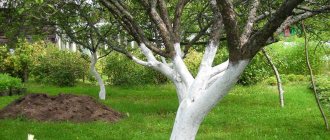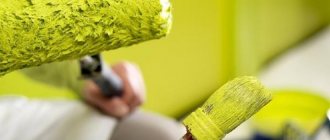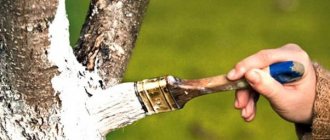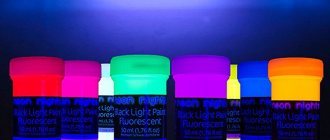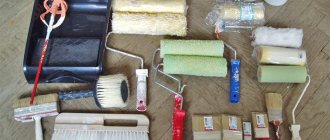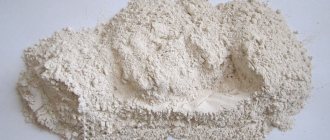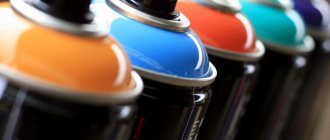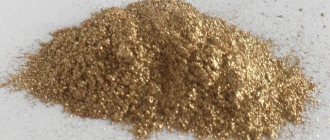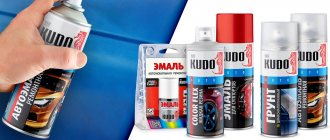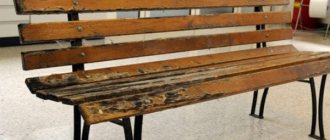It’s good when numerous garden trees grow on the site, bearing delicious fresh fruits... From the outside, everything looks simple, but behind every healthy fruit-bearing seedling there is a huge amount of work and Herculean efforts. Why can you say this?
The fact is that all garden trees should be carefully and regularly cared for. Plants need to be watered, dug up, pruned and painted.
What is meant by this procedure? Why is garden paint needed for trees? What will be the result of using it? And what types of whitewash are there to provide high-quality and effective tree care? Let's find out.
Why should you paint?
Caring for trees in the garden begins in early spring, when the snow barely begins to melt and the first streams flow. Just at this time, when the insects have not yet woken up and the pests have not had time to crawl out of their underground burrows, special paint should be applied to the trees. It will protect the plants from parasites, preventing them from penetrating the tree trunk. If the insects overwintered in the folds of tree bark, then the paint will prevent their further life activity.
As you can see, this method is very useful, as it protects the plant from uninvited guests, promotes its healthy appearance and an abundant, tasty harvest.
What types of protective garden paints are there and how should they be used? Let's find out.
New and old methods
Modern paints for whitewashing garden trees are very easy to use and economically affordable for almost every gardener. If previously, in order to whiten trees, it was necessary to prepare lime with your own hands, strictly following the instructions for mixing the components and strictly observing personal safety measures, now ready-made garden paints for trees are sold almost anywhere.
Now you don’t need to mix several components, you don’t need to waste time on kneading and additional manipulations. You should simply dilute the finished product with water (provided it is too viscous) and apply the resulting composition to the lower part of each garden tree.
But what if you don’t like fashionable products and it’s more convenient to stick to the time-tested method that our grandparents used?
Whitewash components for trees
When making whitewash for trees with your own hands, almost the same components are used in all recipes. Knowing their properties, you can make garden whitewash yourself according to your own recipe. Below I will give the most common compositions of solutions, and now let’s look at what the effects of certain components are.
Chalk or lime - give whitewash a white color and are the cheapest base options for garden whitewash. Freshly slaked lime softens the acidity of copper sulfate if it is present in the recipe.
Clay – needed for viscosity. Whitewash based on it perfectly seals cracks and damage to tree bark. Try to get white clay to get a pure white whitewash that is most effective against sunburn.
Tips for the garden, vegetable garden and flower garden
Proper planting of gladioli in spring
Diseases of eggplant seedlings: description with photographs and methods of treatment
Diseases and pests of pepper seedlings and their control photo
Fungicides are chemicals designed to combat pathogens. For example, Azophos, an inexpensive and high-quality drug produced in Belarus. Advantages: inexpensive, its composition carries a small pesticide load on the tree, easy to use. Disadvantages: it contains a heavy element - copper, the mixture must be stirred periodically when used, it must be used immediately, without delaying the next day.
Copper sulfate is a folk fungicide, the effectiveness of which has been tested by time, rids trees of mold, fungus and microorganisms. For prevention, add 200-300 grams per 10 liters of water. I do not recommend increasing the specific gravity of vitriol in the solution in advanced cases. It is better to carry out additional spraying. Copper sulfate must first be diluted in hot water and cooled.
Carbolic acid will protect your trees from rodents: hares and mice. To do this, just add 1 tablespoon of acid to the prepared 10 liter solution.
Milk – adds viscosity to the solution, making it less fluid.
Casein glue, carpenter's glue or PVA - makes whitewash moisture-resistant and rain-resistant. PVA is the least expensive, but also the worst at allowing trees to breathe.
Cow dung – nourishes the tree directly through the bark.
Ready-made garden whitewash should be brought to a creamy consistency. When whitewashing, the mixtures should not form a layer thicker than 2-3 mm on the bark, and at the same time not flow down.
Lime painting
There is now a lot of slaked lime available. Fluffy is the second name of this product. How should it be used to protect garden trees from insect pests?
First of all, you should think about safety: before you start diluting the dry mixture, you should put on gloves and safety glasses.
It is recommended to mix lime (fluff) in large plastic containers without rust or cracks.
The cooking process is troublesome and quite labor-intensive. It is necessary to carry out the following steps step by step:
- Dilute the fluff at the rate of two kilograms of the purchased mixture per ten liters of water.
- Add two hundred and fifty grams of copper sulfate.
- Add one kilogram of fatty clay.
- Add half a kilogram of cow dung if desired.
The resulting mixture should be liquid, with a consistency similar to low-fat sour cream. The finished whitewash should not flow down the tree trunk. If this happens, you need to add a small amount of clay again.
This method of painting trees, in addition to being labor-intensive to prepare, is also not very effective. Lime whitewash is washed off very quickly, so it does not provide 100% protection for tree trunks.
What to do? How to paint a tree trunk so that the effect is long-lasting and does not require a lot of time and effort?
Other uses
In addition to protecting tree trunks, it is also used to disinfect the crown. To do this, the composition is diluted with water based on the calculation of 1 kg of paint per 10 liters of water, and the branches are treated with a spray bottle. For the same purposes, bushes, hanging plants, as well as flower bulbs for flower beds are sprayed. Processing the grapes will prevent early bud break and protect against late frosts.
To protect bulbs and root vegetables from hares and small rodents, you should prepare several slats of wood and paint them with garden paint. Then stick it around the beds where rodents are encroaching. Sensing the smell emitted by special components, animals will avoid approaching the garden.
Utility and utility rooms, garden furniture and decorative wooden elements are treated to protect against sunlight. It will prevent rotting and protect against parasites, which will significantly increase its service life. Forming a protective layer that prevents the spread of insects in wooden parts of furniture. In addition, painted white, it will have a beautiful appearance. Many types of paints can be mixed with color pastes, so summer residents have a wide choice of colors for their garden furniture.
Advantages of the finished product
As mentioned above, there is ready-made garden paint for trees. Its cost is much higher than fluff, but the result is worth it.
One of the important qualities is that the durability of such whitewash is two years (for adult garden specimens) and one year (for seedlings). This is due to the rapid growth and expansion of the bark of young trees.
Moreover, thanks to its components, this paint can repel not only insects, but also rodents.
Here are some more benefits of using ready-made products:
- Protecting the tree trunk from sunburn.
- A universal composition suitable for all types of garden plants.
- Prevention of such serious diseases as rust, fruit rot, scab and others.
- Protecting the tree in severe frosts.
- Increased moisture resistance.
Most likely, taking into account the advantages listed above, you will want to try special garden paint for trees on your site. What types of this processing method exist and how to choose the best one?
Listed below are the main types of paints, differing from each other in composition and main components.
Water-based
Very effective protection against sudden changes in air temperature and in too bright sunlight. Most water-based paints are based on acrylic resins, which protect trees from rotting and the spread of various types of bacteria. However, acrylic paints do not protect against pests, so it is recommended to add special substances containing copper to ready-made solutions. You should only choose acrylic paint marked “for garden trees.” Must be applied in warm, windless weather.
What do you usually use to whiten trees?
Whitewashing trees is an important agrotechnical technique, the main task of which is to protect trees.
First of all, the treated tree is not afraid of sunburn on the bark, and can develop better throughout the warm season.
Secondly, whitewash serves as an additional protective layer from temperature changes. That is why, under ideal conditions, trees are whitened in early spring and/or late autumn - first to protect them from heat and then from severe frosts.
Finally, whitewash applied in a thick layer effectively prevents the spread of fungi and other plant diseases on the bark. And if you add something to the product, the whitewash will last longer and additionally repel insect pests, even some rodents.
Moreover, the most common and at the same time simplest ways to whiten trees is to prepare a solution of slaked lime or dilute a chalk-based product.
However, there are a large number of other folk techniques or ready-made purchased products, where in addition to whitewashing, the composition contains adhesives, insecticidal or fungicidal preparations - all so that simple whitewashing of trees at the same time, in addition to the protective function, additionally solves the problem of useful, effective, feeding processing.
Water-dispersed
The composition of the liquid mixture is unique. Here are present:
- antiseptics (protect tree trunks from pests);
- white pigment (prevents destructive processes occurring as a result of ultraviolet irradiation);
- latex (provides durability and long-lasting coverage).
An important component of the product must be acrylic, which will prevent the paint from being washed off under the influence of precipitation.
This type of product repels rodents and insects, so no additional components should be added to it.
There are several common varieties of this garden paint for trees. “Luck” is one of them. It is easy to use and safe for any type of plant, even the youngest.
The next type of acrylic water-dispersed garden paint for trees is “Ecosil”. Garden emulsion improves the frost resistance of plants. In some cases, it can serve as a growth stimulator for garden trees and shrubs.
How to whitewash plantings?
- the trunk must be completely whitewashed - a segment of the trunk from the root collar to the first skeletal branch in the lower tier;
- 1/3 of the length of the lower skeletal branches.
Such a light-repellent coating, in fact, should cover the tree completely, but this is expensive and too troublesome. There are various mixtures for whitewashing trees: lime mortar, water-dispersion, water-based paints. The main thing is that the composition for these purposes must be breathable and last a long time. For this purpose, laundry soap, milk, clay, PVA or casein glue are added to the main mixture.
Aerosol
Recently it has begun to attract the attention of modern gardeners and summer residents. This type of paint is produced in a can, similar to an aerosol spray. Convenient for use in hard-to-reach places, it has the same properties as liquid representatives of ready-made whitewash. Despite the fact that it is applied in a thin layer, it fills even the narrowest and smallest cracks and notches in the tree bark with the solution.
It is recommended to apply aerosol paint at a distance of thirty centimeters (the can should be shaken beforehand) at an air temperature of at least ten degrees plus.
So, we have looked at the advantages of painting trees, as well as the positive and negative aspects of the finished product. We also briefly learned about some types of garden paints.
Now let's talk about how to use these liquid products for quality care and effective protection of trees from pests and diseases.
Optimal time of year
Where to start preparatory work for painting or whitewashing trees? First of all, you need to decide when to carry out the manipulations. The most important thing is to carry out painting on a dry and windless day. If you want to start coloring in the fall, you should wait until the end of the rainy season. If it is more convenient for you to whitewash trees in the spring, then you should carry out the procedure after warm weather sets in, when the thermometer rises above seven degrees with a plus mark.
There are a number of detailed recommendations for spring painting:
- Don't wait for the earth to warm up. This can lead to insects waking up, and then whitewashing the trees will become practically ineffective.
- If the autumn painting of tree trunks was not carried out for some reason, then spring manipulations are recommended to be carried out in two stages: in the last days of February and in mid-April.
Selecting a device
Preparing for whitewashing trees also includes choosing the right tools. First of all, think about what would be more convenient for you to paint with – a brush, a roller or a spray gun. In addition to personal preference, you should pay attention to the special purpose of each tool.
For example, thanks to the right brushes, you can use garden paint economically. Rollers will help paint thick tree trunks with equal precision, and will also facilitate the penetration of liquid into various cracks and depressions formed on the surface of the bark. Modern spray guns will save time and effort, since with their help, painting trees will be carried out several times faster than with the tools listed above.
When choosing dyeing devices, it is also recommended to take into account their size so that they match the thickness of the trunk and branches of garden plants.
During the work, you can use several tools, combining them with each other depending on the surface of the tree or shrub.
Preparing for painting
Before applying paint, you should carefully prepare the tree bark. What needs to be done for this?
First of all, it is recommended to clean the surface of the bark from dust and dirt, as well as scrape off moss and all kinds of lichens. This can be done using a wire brush or scraper. It is recommended to collect and burn the peeled bark that falls down, as it may contain sleeping larvae or eggs of pests.
As a universal preventive measure, or if the tree has damage and cracks, the bark should be treated with garden varnish. It is also possible to impregnate the bark with alkaline agents to destroy possible microbes and parasites located in the trunk.
After such manipulations, the surface of the wood must completely dry, and only then will it be necessary to whitewash it.
Whitewashing trees: rules
- It is necessary to process not only the trunk from below, but also the skeletal branches - as in the photo.
- On many sites I saw a recommendation not to touch young trees. My dad and I have been whitening even yesterday’s seedlings for years. I have never noticed that the trees reacted poorly to the procedure - on the contrary, this way they take root even better. However, when processing such trees for the first time, you can prepare a less “vigorous” whitewash by adding half the normal amount of each component.
- Copper sulfate is not poured in powder form. It must first be dissolved in a cup of hot water, and only then poured into the whitewash.
- The ideal consistency of whitewash is like sour cream, without lumps.
- Before whitewashing, you should remove moss and dead bark from the trunk. If this results in cuts, carefully treat them with garden varnish.
And here’s how a professional agronomist looks at whitewashing. In this video, he will tell you how, when and why it is necessary to whiten the trunks of fruit trees, and in addition, he will share his opinion on the best remedy:
